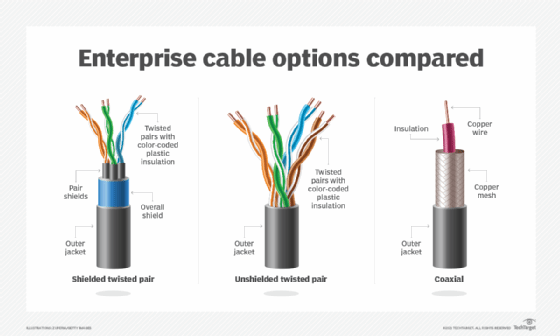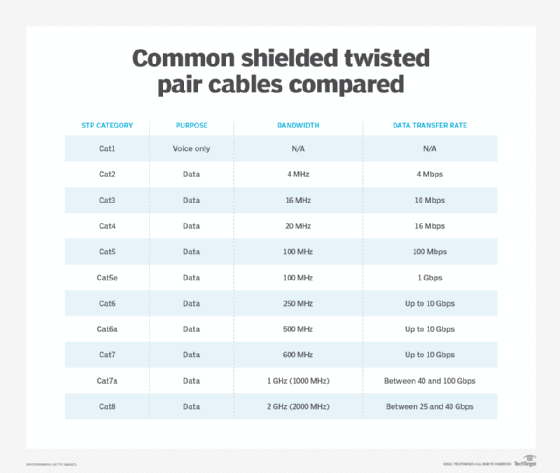What is shielded twisted pair (STP) and how does it work?
Shielded twisted pair (STP) is a kind of cable made up of smaller wires where each small pair of wires is twisted together and has an outer coating to electrically shield it. STP is used for telephone and local area network (LAN) wiring. Shielded means it has an outer covering or shield that functions as a ground to ordinary twisted-pair wiring.
Twisted pair is the ordinary copper wire that is used in many computer networks for low speed and short runs of wires. To reduce cross-talk or electromagnetic induction between pairs of wires, two insulated copper wires are twisted around each other. Each signal on twisted pair requires both wires.
Unlike unshielded twisted pair (UTP), shielded twisted pair also encloses these wires in a shield, or conductive coating, and grounds them to further reduce electromagnetic and radio frequency interference. STP cables are more expensive than UTP wiring.
Fiber optics is increasingly replacing STP for long runs of data. As the cost of fiber optic transceivers has come down, the cost of cables has gone up. The increased cost of cable is often attributed to the scarcity of copper. Additionally, fiber optic cables can be easier to work with. A bundle of cables as thick as an arm can be replaced with a single fiber optic strand.
Many businesses now have fiber optics for all the backhaul transmission and STP Ethernet cables only for the short distance from the wall jack to the end device.

How is shielded twisted pair wiring installed?
Since some telephone sets or desktop locations require multiple connections, twisted-pair wiring is sometimes installed in two or more pairs -- all within a single cable. Businesses often use shielded twisted pair in their cabling system installations, while the more common kind of wire installed in homes is UTP.
Frequently, twisted pair is now installed with two pairs of cables to the home. The extra pair makes it possible to add another line -- perhaps for modem use -- when needed.
Twisted pair -- be it UTP or STP -- also comes with each pair uniquely color-coded when it is packaged in multiple pairs. Different uses, such as analog, digital and Ethernet, require different pair multiples. So, the color-coding makes it easier to differentiate between pairs.
Businesses often use a higher grade of twisted pair for horizontal wiring in LAN installations because it is less expensive than coaxial cable. Coax and fiber optic cabling are the main alternatives to twisted pair.
In electrically noisy business environments, shielded twisted pair is used in RJ-45 and RJ-11 connectors and with RS-449 and RS-232 standards to maximize the reduction of interference.
How does shielded twisted pair differ from Ethernet or telephone cable?
The requirements for voice telephone, often called plain old telephone service, are low compared to high-speed data. A common type of telephone cord is a four-conductor untwisted variety with an RJ-11 jack. It is a side-by-side wire known as silver satin.
These types of basic untwisted telephone wires may also carry data. This is known as Category 3 (Cat3) wire. These are mostly used at 10 megabits per second but can be pushed to 100 Mbps. This is often exploited in older buildings that were originally wired for telephones. These old cables can work with both voice and data service as needed. This approach is being phased out, though.
Modern buildings are now wired with high-speed data-only cables, known as Ethernet cables. Voice over Internet Protocol telephones may be used to provide desk phone service using data cables.
What are the differences among STP, FTP and S/FTP, and UTP?
Let's take a quick look at the differences between shielded twisted-pair cables and some twisted-pair alternatives:
- STP. Shielded twisted-pair cabling acts as a conducting shield by covering the four pairs of signal-carrying wires as a means to reduce electromagnetic interference. There are a variety of different types of STP cables, such as foil twisted pair and shielded FTP (S/FTP).
- FTP. There are also STP cables that use a lighter foil shield. However, note that bend radius and pulling tension must be monitored during installation to prevent these shielded cables from tearing.
- S/FTP. To avoid the possibility of tearing, there are also STP cabling systems that use a thick braided shield to make the cable sturdier. Essentially, the individual pairs of wires inside the cable are twisted and shielded to provide the best protection against cross-talk and electromagnetic interference.
- UTP. The more common kind of wire installed in a home is unshielded twisted pair. Unlike STP, FTP and S/FTP, UTP cables do not possess physical shielding to block interference. Instead, UTP relies on media filters and baluns -- a construction from balanced to unbalanced -- as balancing and filtering mechanisms.
In essence, the main difference between these cable types is their design. However, their purpose is the same: to provide reliable connectivity to communications hardware.
STP and data transfer rates
Shielded twisted pair comes in a variety of cable categories. The most popular in use today are Cat5e, Cat6, Cat6a and Cat7. Let's take a closer look at the different STP categories and compare their bandwidth and maximum high-speed data transfer rates. As the data rate goes up, the possibility of interference goes up, making the shielding more important.

Twisted-pair cable and Power over Ethernet
Power over Ethernet (PoE) is a way to send data and power over twisted-pair cabling. Commercial data switches often offer PoE.
PoE is convenient because it can be used to power devices that may be in hard-to-reach places or that are embedded in a building. Some types of devices that may take advantage of PoE are security cameras, security card readers or wireless access points.
PoE relies on twisted-pair cables to send both power and data on the same wire. In twisted-pair Ethernet, it doesn't use the absolute voltage to indicate data; it uses the difference between the two wires in the twisted pair. This removes interference, but it also allows for a constant voltage to be applied to the pair. This constant voltage is used by PoE to send power to the receiving device.
The primary types of network cables -- coaxial, fiber optic, and shielded and unshielded twisted pair -- play a crucial role in any network setup. As businesses embrace new technologies, choosing the right cables is vital for optimal performance and reliability. Explore the different types of network cables.







